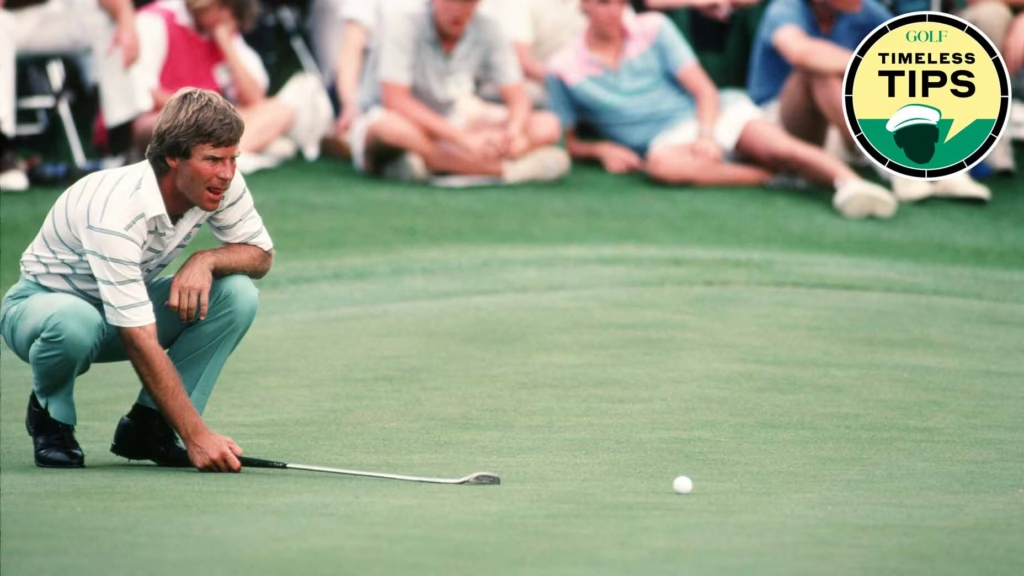Golf instruction is ever-evolving, but the best advice stands the test of time. In this GOLF.com series, Timeless Tips, we’re highlighting some of the greatest advice teachers and players have dispensed in the pages of GOLF Magazine. Today we look back to an article from our April 1978 issue in which Harvey Penick shared the secrets to great putting.
Ben Crenshaw’s putting stroke is one of the best ever. The long and languid move brought him tons of success, including 19 PGA Tour titles and two green jackets, culminating in a spot in the World Golf Hall of Fame.
Gentle Ben honed his craft on the grainy greens of Austin, Texas, under the guidance of his lifelong coach, the late Harvey Penick. There aren’t many coaches in the history of the game who command as much respect as Penick — and for good reason. His teachings guided some of golf’s all-time greats, and his Little Red Book became gospel for many more.
If you’ve never digested any of Penick’s teachings, do yourself a favor and dive in now. The legendary Texan had a knack for simplifying even the most complex of topics, and his track record is hard to argue.
Back in the late 1970s, Penick joined GOLF Magazine to share some of his wisdom on developing a proper putting stroke on the greens. You can check it out below.
Harvey Penick’s keys for great putting
It often has been said the best teachers are those who teach least. Harvey Penick is a dramatic case in point. His most famous pupil, Ben Crenshaw, is acknowledged as one of the best putters in the game. Yet the lessons Harvey did not give him — on putting — may have been the most valuable.
“If I can see natural ability,” says Penick, “I’m not going to fool with anyone. Ben might have gotten that nice, long, smooth stroke from his father, who has one just the same. I believe you inherit muscles that are conducive to certain kinds of strokes.”
There also is an emotional makeup “conducive” to a certain type of putting stroke, Penick suggests.
“It takes steadier nerves for that good, long stroke. A nervous individual can’t putt that way. He tends to have, or maybe should have, one of those short, snappy strokes.”
Still, Penick believes this “feel” must be combined with sensible fundamentals, and in the following article refutes many of the much espoused theories on putting.
Grip
Horton Smith, a very fine putter in his day, always believed you should — hit against a locked left wrist, and believe that still holds. But the more interesting development in putting — over the past 10 years or so has been the positioning of the right hand. Check players like Nicklaus, Palmer and Casper and you’ll see that the | right hand is in a “strong” position, rolled slightly clockwise and under the shaft of the putter.
If a man puts his hand more on top of the shaft, the general position for hitting full shots, he’s going to roll over on it. The putter blade has a much better chance of staying square if the right hand is under the shaft a bit.
You don’t want that strong position for hitting the other shots, which goes along with my feeling that you don’t putt the same way as you swing a hitting club. I don’t tie them together for one reason — the putter is not made like the rest of the clubs.
A chip shot is nothing but a little drive, because the ball is played to be hit at the lowest point of the arc. In putting, at impact, that arc should be extremely shallow. You simply don’t need the kind of power you get with a grip that allows the right hand to roll over.
Grip pressure
I like the words “at ease,” because if you get too relaxed and loose I’m afraid that in the pinch you’re going to snatch it, grab the club at impact.
Ben Crenshaw says these are the 3 keys to being a great putter
Zephyr Melton
Whether you hold the putter tight or loose is determined by how far you’re going to hit the ball. That holds for all shots. If you’re going to hit the ball as hard as Arnold Palmer does, you’re going to hold the club tighter than if you are going to hit it as hard as my wife does. In putting, you simply hold it tight enough to control the club.
Alignment
If you have trouble lining up, you should walk up to the ball from behind, glance at the putter blade, then the hole, put the blade down square to the line and take your stance. The blade often looks crooked because you look at it so much from above and thus lose the sense of angle. But if you get the blade into position the way I suggest you’ll be fine.
Lie
Almost everybody flexes their knees some at the address, or should. The way to know the putter is setting right for your build or the type of stance you take is to look at the angle of the shaft. It should conform with the angle of your thighs. The more you “sit down” to the ball, the more tilt to the angle of the shaft and vice versa.
Ball position
At address your eyes should be directly over the ball. You can test yourself by holding a putter to your eye and letting it hang vertically. If you should drop it, the putter should hit the ball. You might be somewhat inside the ball or behind it, like Nicklaus, but you should never be outside or in front. You should never lean so far forward that you are looking back at the ball, because it is very difficult to see if the blade is square.
Now I don’t like to give up a good stroke, one that works. But I believe a low-to-the ground takeaway is the best. You get that by playing the ball off the left heel or even the left toe. The farther toward the right foot you play the ball, the higher the backstroke will be, and if you’re high on the backstroke, you’re going to hit the ball with a descending blow.
I’m not too concerned about the follow-through because the ball has already been hit. I do believe, though, that the length of the follow-through should match the length of the backstroke.
The stroke
I’m sometimes criticized in my teaching for allowing people more play in their bodies. But some people, particularly women, have to have some. That’s mostly in respect to full swings, but I also believe a little movement, or freedom, in putting is not bad.
Ben Crenshaw: These are my 5 ‘musts’ for great putting
Zephyr Melton
Those knees together to keep from moving helped Arnold Palmer be a very bold long putter. I don’t like to say I told you so, but I always did say one day he’s going to have to make those three-footers coming back, and I’m afraid that’s what has happened. I don’t mean you should move a lot, maybe none at all, but if your body is too rigid over the ball you’re going to lose some feel.
Short vs. long
I teach that on short putts you concentrate on line. If you practice enough, your muscles will tell you how hard to hit the ball. For long putts you concentrate on distance. Practice as though you were pitching pennies. You want to stop the ball at the right distance to give luck a chance. I don’t like the notion, “Never up, never in.”
Very few putts are left short if a ball is hit solidly, and I believe every once in a while, when practicing, you should put some chalk on the back of the ball to see where you’re catching it on the blade.
Breaking putts
I don’t believe in picking a spot around the hole. I think you should picture the entire roll or curve of the putt. I also think it is wrong for a golfer to rely on a caddie or anyone else to give him the line, because only the golfer knows how hard he’s going to hit the ball. Speed of putt is important. Once you’ve decided how you’re going to putt, go with it.
Now I have an aspirin for those of you who have trouble with breaking putts. For either break, but especially right-to-left, which is probably the hardest for right-handed golfers, I suggest hitting the ball off the outside end of the blade, near the toe. That’s for shorter putts. Most golfers who miss right-to-left putts are hitting the ball on the heel, because they throw the clubhead out to be sure they get the ball high enough. They heel the putt and give the ball the wrong spin.
Confidence
I think everybody who wants to pay the price can become a good putter. The price is practice, although admittedly it can be kind of dull.
There also are certain people who can make a putt when they most need it. An old story about Harry Vardon relates that he missed a short putt once, and a fellow in the gallery told him he should have made it, that it was a pretty easy one. Harry bet the man a hundred pounds he couldn’t make a three-footer. The bet was advertised, a gallery came out to watch, and, of course, the man missed.
Now, confidence, I believe, is the result of making putts — not the cause of it. I’ve been studying the words faith and confidence an awful lot. A friend, who knows words, gave me this: You have faith first and then confidence. If a pupil believes what I teach him, or what he learns any other way, and will work on it, he’ll gain confidence when he starts making them.
People have asked me what the three most important shots in golf are. Ben Hogan says that it’s drive, chip, putt. In professional play that seems correct. But for the mass of golfers, I believe the order is putt, drive, and chip.
Perfect Putting Mat™ – Standard Edition
Trusted & Used by Over 100+ PGA Tour Pros!
View Product
Discover more from 6up.net
Subscribe to get the latest posts sent to your email.


